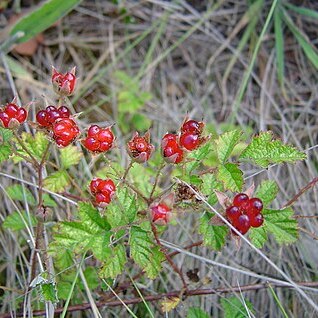Shrubs 1–2 m tall, with arching branches. Branchlets grayish brown or reddish brown to blackish brown, with soft hairs and sparse, curved prickles. Leaves imparipinnate, 3–5-foliolate; petiole 2.5–5 cm, terminal leaflet 1–2 cm, petiolulate, lateral leaflets subsessile, with soft hairs and sparse, minute prickles; stipules linear, 7–10 mm, soft hairy; blade of leaflets rhombic-orbicular or obovate, 2.5–6 × 2–6 cm, abaxially densely gray tomentose, adaxially appressed-pilose, base rounded or broadly cuneate, margin unevenly coarsely serrate or coarsely incised-doubly serrate, often lobed, apex obtuse or acute. Inflorescences terminal, corymbose, rarely short racemes, 4–8 cm, several to many flowered, axillary inflorescences corymbose; rachis and pedicels pubescent, with minute prickles; bracts linear, 6–10 mm, pubescent. Pedicel 0.5–1.5 cm. Flowers ca. 1 cm in diam. Calyx abaxially densely pubescent, with unequal long needle-like prickles; sepals erect, spreading, ovate-lanceolate or lanceolate, 5–8 × 2–4 mm, apex acuminate, occasionally laciniate. Petals pink to purplish red, ovate-orbicular or oblong, 4–6 × 3–4 mm, base clawed. Stamens numerous, somewhat shorter than petals; filaments white, linear. Pistils slightly longer than or ca. as long as stamens; ovary pubescent. Aggregate fruit red, ovoid-globose, 1–1.5 cm in diam., glabrous or somewhat pubescent; pyrenes shallowly rugose. Fl May–Jun, fr. Jul–Aug. 2n = 14*, 21*, 28*.
More
Shrubs, 1–3 dm, armed. Stems ?biennial?, low-mounding to creeping, sparsely to moderately hairy, glabrescent, eglandular, not pruinose; prickles sparse to moderate, slightly to strongly hooked, weak to stout, 0.8–1.5(–2) mm, broad-based. Leaves deciduous, ternate or pinnately compound; stipules filiform to linear, (4–)6–11 mm; leaflets 3(–5), terminal broadly ovate-rhombic to obovate, (2–)3–5(–9) × 2.2–5(–7.5) cm, base cuneate to obtuse, slightly 3-lobed, margins coarsely serrate to doubly serrate, apex acute to obtuse, abaxial surfaces with slightly to strongly hooked prickles on veins, densely whitish-tomentose, eglandular or sparsely short-stipitate-glandular. Inflorescences terminal and axillary, 2–20-flowered, cymiform to thyrsiform. Pedicels: prickles moderate, slightly to strongly hooked, moderately hairy, eglandular or sparsely short-stipitate-glandular. Flowers bisexual; petals pinkish to magenta, oblanceolate to obovate, 4–7 mm; filaments filiform; ovaries moderately to densely hairy, ?styles glabrous?. Fruits red, round, 0.6–0.9 cm; drupelets 10–50, strongly coherent, separating from torus. 2n = 14.
An evergreen shrub. It is weakly climbing or trailing. It grows to 60 cm high and spreads to 1-3 m across. The stem is trailing and prickly The leaves have 3 leaflets. The leaflets are 2-6 cm long. The leaves have teeth around the edge. These have a silvery under-surface. The flowers are small and pink. The fruit are red. They have a few, large, pointed grains.
Forests, thickets, clearings, slopes, sunny valleys, roadsides, waste places; at elevations from 400-2,700 metres. Mainly found in wet sclerophyll forests in eastern Australia.
More
It is a subtropical to temperate plant. It will grow on most soils. It is drought and frost resistant. In Sichuan and Yunnan.

